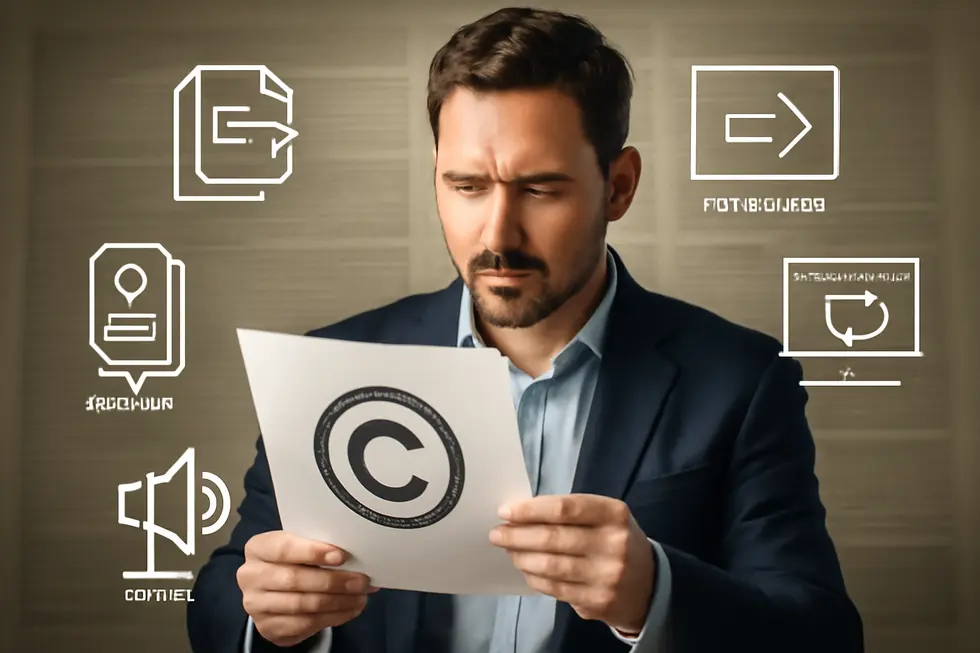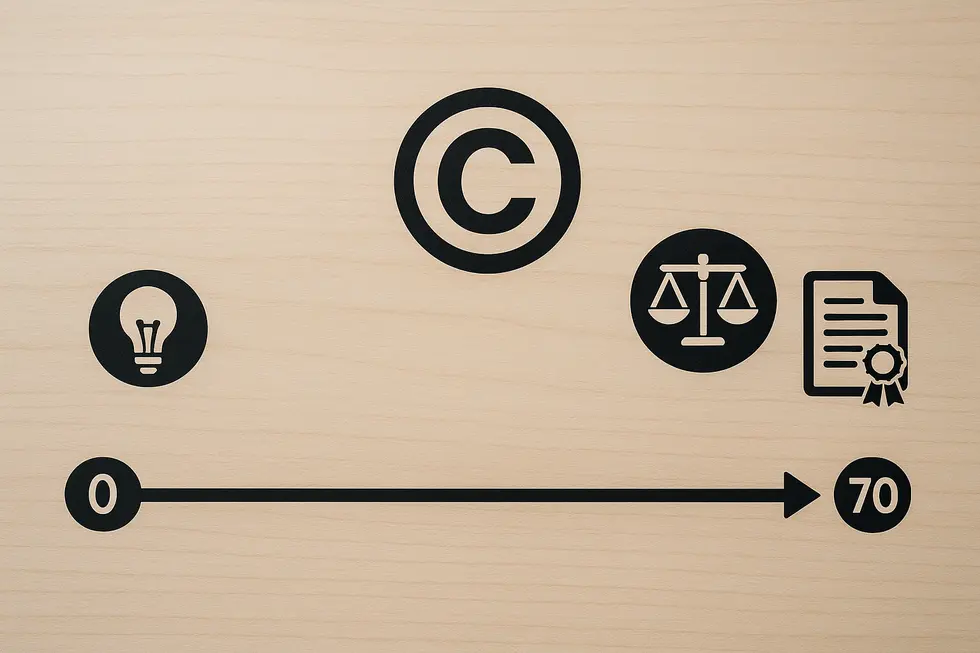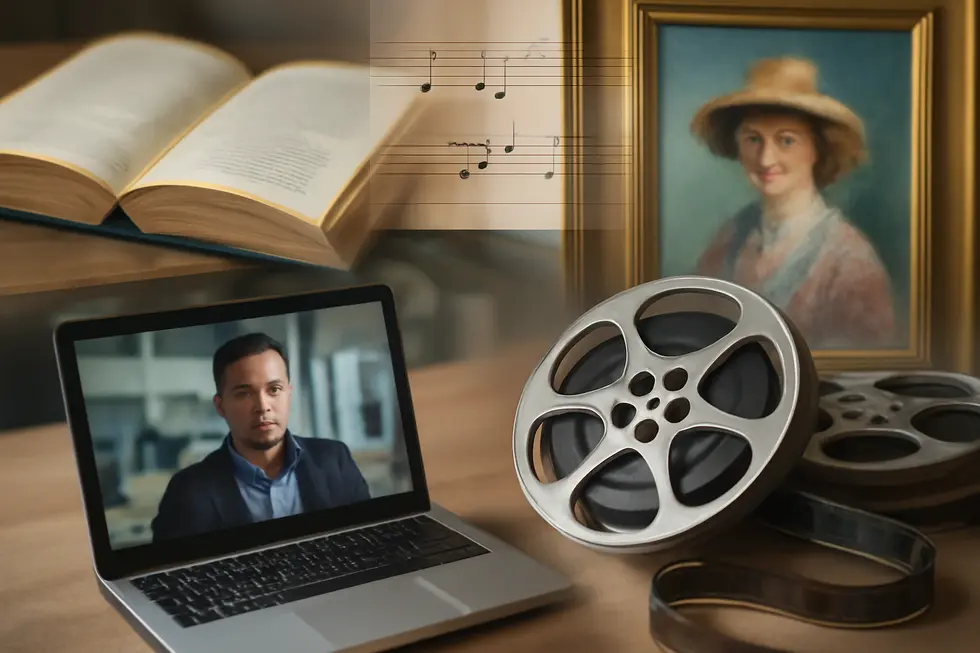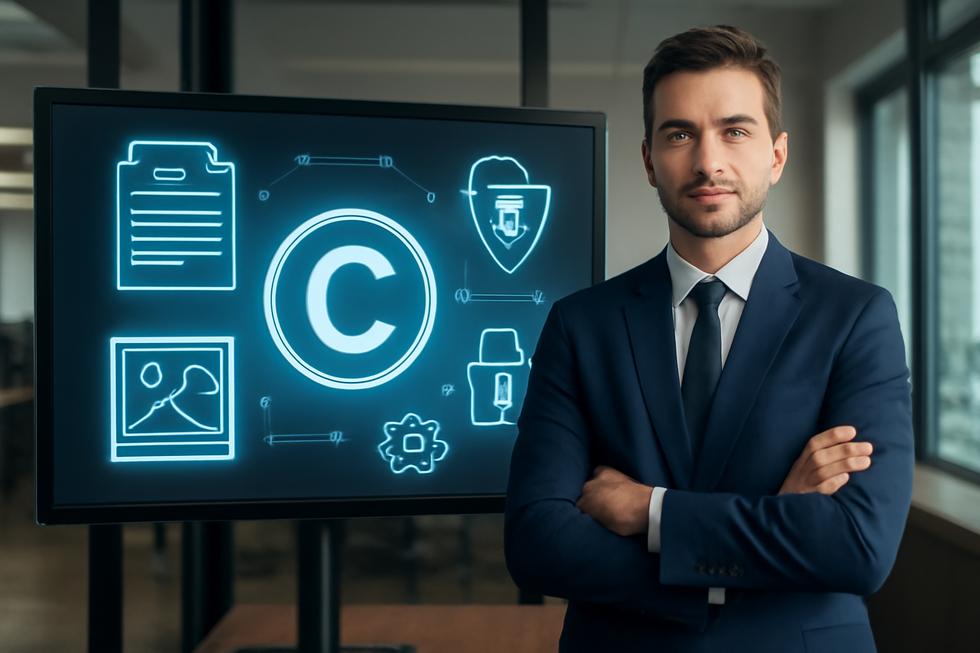Introduction
Exclusive rights in copyright are powerful legal tools that business owners must understand to safeguard their creative assets and maximize value. These rights grant creators control over how their original works—whether written content, designs, or performances—are used, distributed, and monetized. For businesses, grasping the nuances of exclusive rights ensures protection against unauthorized use, opens doors for licensing opportunities, and secures competitive advantage in the marketplace. This guide unfolds across four critical dimensions: defining exclusive rights and their privileges; explaining their duration and legal context; exploring economic impacts through licensing; and clarifying the categories and practical applications of these rights. Together, these insights equip business owners with essential knowledge to navigate copyright with confidence and strategic intent.
Tables of Contents
Chapter 1: Understanding Exclusive Rights in Copyright: Definitions and Core Privileges
- The Legal Foundation and Property Nature of Exclusive Copyright Rights
- Navigating Copyright’s Core: How Reproduction and Distribution Rights Empower Creators
- Public Performance and Display: Empowering Creators’ Control Over Public Use
- Derivative Works: Essential Exclusive Rights Shaping Creative Adaptations
- Navigating Licensing and Ownership Transfers: Empowering Control Over Copyright’s Exclusive Rights
Chapter 2: Duration and Legal Framework of Exclusive Rights in Copyright
- Navigating the Lifespan and Legal Boundaries of Copyright’s Exclusive Privileges
- Navigating the Duration and Limitations of U.S. Copyright Exclusive Rights
- Unpacking UK Copyright Duration and Exclusive Rights: Historical Roots and Modern Legal Structure
- Navigating the Transfer and Reversion of Copyright Exclusive Rights
- Navigating the Boundaries: How Duration, Fair Use, and Common Law Shape Exclusive Copyright Rights
Chapter 3: Licensing and Economic Implications of Exclusive Rights in Copyright
- How Licensing Exclusive Rights Fuels Revenue and Market Dominance
- Legal Foundations Driving Licensing Control and Economic Value of Exclusive Copyright Rights
- Navigating Ownership and Control: Economic Dynamics of Copyright Transfer versus Licensing
- Maximizing Value Through Strategic Licensing of Exclusive Copyright Rights
- Navigating the Intersection of Economic Incentives and Public Access in Exclusive Copyright Licensing
Chapter 4: Comprehensive Insights into Categories and Applications of Exclusive Copyright Rights
- Unpacking the Statutory Rights and Legal Framework Governing Exclusive Copyright Privileges
- Navigating Technological Shifts: Reproduction and Distribution in Copyright’s Exclusive Rights
- Harnessing Exclusive Rights: Economic Impact and Licensing Approaches in Copyright
- Global Enforcement Dynamics of Exclusive Copyright Rights: Geopolitics and Emerging Challenges
- Balancing Exclusive Rights with Education: Societal Benefits and Legal Exceptions
Chapter 1: Understanding Exclusive Rights in Copyright: Definitions and Core Privileges

1. The Legal Foundation and Property Nature of Exclusive Copyright Rights
Exclusive rights in copyright grant the legal authority to control and authorize specific uses of original creative works. These rights arise under intellectual property law, which treats copyright as a form of intangible property bestowed upon creators. Through this legal framework, copyright holders obtain exclusive privileges to reproduce, distribute, publicly perform or display, and create derivative works from their creations. These core privileges empower the copyright owner to decide how their work circulates and is adapted, safeguarding both legal and economic interests.
From a property perspective, copyright ownership can be wholly transferred or licensed. Licensing may be exclusive—granting sole rights for specific uses—or non-exclusive, allowing multiple users. Importantly, exclusive licenses do not automatically convey full ownership unless explicitly stated. This distinction preserves the original author’s ultimate rights while permitting controlled sharing and monetization.
These carefully defined rights are enforceable under law, preventing unauthorized exploitation and fostering creativity by ensuring creators benefit from their work. For deeper legal context on copyright licensing and rights, additional guidance can be found through ContractsCounsel’s copyright license agreement overview. For further insight into the basic concepts and economic importance of copyright, consult this resource on copyright definition and economics for business.
2. Navigating Copyright’s Core: How Reproduction and Distribution Rights Empower Creators
Reproduction and distribution rights form the backbone of exclusive powers granted under copyright law. The reproduction right gives the copyright owner sole authority to make copies of their original work, whether in whole or part, safeguarding against unauthorized duplication. This right ensures that creators control how their work is fixed in tangible forms, such as print or digital media. Alongside this, the distribution right controls the public dissemination of copies by sale, rental, lease, or lending. Only the copyright holder can authorize or restrict these uses, making this right essential to regulating how works circulate in the marketplace.
Together, these rights enable creators to capitalize on their efforts, often through licensing agreements that grant others permission to reproduce or distribute under specific conditions. The balance between protecting creators and public interest is maintained by time-limited terms and legal exceptions. Rooted in constitutional authority, these rights incentivize innovation and cultural growth by ensuring exclusive control while allowing eventual public access. For a deeper understanding of how distribution rights affect businesses, see this detailed discussion on copyright distribution rights.
For further context on the ethical and legal basis of these privileges, the University of Portland offers valuable insights into ethical use and copyright.
3. Public Performance and Display: Empowering Creators’ Control Over Public Use
Public performance and public display are key exclusive rights that empower copyright holders to regulate how their creative works reach audiences in public settings. These rights extend beyond mere ownership, ensuring that creators retain control over the manner and context in which their works engage the public. Public performance covers any live or recorded presentation of a work to an audience, such as a musical concert, theatrical play, or film screening. Whether played through speakers at a venue or performed on stage, this right requires permission from the copyright owner, typically managed by collective rights organizations that distribute royalties fairly. Similarly, public display pertains to showing visual works like paintings, photographs, or digital images in settings accessible to the public. Whether displayed in galleries, schools, or online platforms, authorization is essential unless specific exceptions apply. Together, these rights form an integral part of the exclusive privileges that allow creators to monetize and protect their works’ public presence. Unauthorized use in these contexts constitutes infringement, underscoring the importance of licensing in maintaining the economic and legal framework supporting creative industries. For more on the economic dimensions of copyright, reference copyright definition economics for business. External: https://dj.studio/blog/dj-licence
4. Derivative Works: Essential Exclusive Rights Shaping Creative Adaptations
Derivative works represent a pivotal exclusive right within copyright law, granting the original creator control over new adaptations that build upon their initial work. This right empowers authors to authorize or prohibit alterations such as translations, dramatizations, sequels, or other transformative modifications. For instance, adapting a novel into a screenplay or translating its text involves creating a derivative work, which legally requires consent from the original copyright owner. These protections uphold the author’s creative authority while ensuring that derivative works contain sufficient originality beyond mere replication.
To qualify for copyright protection, both original and derivative works must meet specific criteria: originality, human authorship, and fixation in a tangible medium. These requirements safeguard the unique elements of creative expression even as works evolve into new formats or interpretations. Among the core privileges outlined in the Copyright Act are reproduction, distribution, public performance and display, and crucially, preparation of derivative works — highlighting the importance of this right in shaping how creative content may be reused or expanded.
This exclusive control over adaptations not only preserves the creator’s economic interests but also influences how culture and ideas evolve through authorized transformations. For further details on these core privileges under U.S. law, see the Indiana University Libraries’ Copyright Guide.
5. Navigating Licensing and Ownership Transfers: Empowering Control Over Copyright’s Exclusive Rights
Licensing and ownership transfers are fundamental legal tools that shape how copyright owners manage their exclusive rights. Licensing grants permission to others to use some or all of the copyright owner’s exclusive privileges—such as reproduction or distribution—without surrendering ownership. Licenses may be exclusive, allowing only one party to exercise the rights, or non-exclusive, permitting multiple users simultaneously. These agreements carefully outline the scope, duration, payments, and conditions, ensuring clear boundaries for use. Conversely, transfers or assignments involve a written conveyance of ownership, passing some or all copyright rights fully to another party. Once transferred, the new owner gains full legal authority to use or enforce those rights independently. Such transfers commonly occur in publishing or production deals, where authors give publishers ownership, affecting future permission requirements. Understanding these mechanisms is crucial for anyone managing copyright to legally protect, monetize, or use creative works. For further insights on licensing structures and contracts, see Contracts Counsel on Intellectual Property Rights Agreements[^2]. Additionally, explore more on copyright’s distribution rights in business at copyright distribution rights in business.
Chapter 2: Duration and Legal Framework of Exclusive Rights in Copyright

1. Navigating the Lifespan and Legal Boundaries of Copyright’s Exclusive Privileges
Exclusive rights in copyright are anchored in a temporal framework closely tied to the author’s life cycle. For works created by individual authors, these rights endure for the author’s lifetime plus 70 years, providing extended protection that benefits heirs and encourages ongoing creativity. In contrast, works made for hire or those published anonymously or under pseudonyms enjoy a fixed term of either 95 years from publication or 120 years from creation, whichever expires first, reflecting different considerations in ownership and use. During this period, copyright owners hold five essential exclusive privileges—reproduction, distribution, public performance, public display, and the right to create derivative works. The legal foundation ensures these rights arise automatically upon fixation of the work in a tangible medium, without the need for registration, aligning U.S. law with international norms such as the Berne Convention. Furthermore, the law provides authors or their heirs opportunities to reclaim rights through statutory termination of transfers, usually decades after an initial assignment, enhancing control over usage as cultural and commercial contexts evolve. Ultimately, once the copyright term expires, works enter the public domain, expanding access and creative possibilities for all. This interplay of time, legal protection, and authorial legacy forms the backbone of exclusive rights’ legal framework. For more detailed insights on copyright duration, see the Connecticut State Library Copyright Guide.
2. Navigating the Duration and Limitations of U.S. Copyright Exclusive Rights
Under U.S. copyright law, exclusive rights grant creators strong control over their works, balanced by a defined duration and important limitations. For individual authors, copyright typically lasts for the life of the author plus 70 years, enabling long-term protection and economic benefit. Corporate works, anonymous, or pseudonymous creations receive protection for 95 years from publication or 120 years from creation, whichever expires first. These durations encourage creativity while eventually enriching the public domain.
The legal framework secures rights to reproduce, distribute, publicly perform and display, and create derivative works. Protection arises automatically once a work is fixed in a tangible form, though formal registration offers enhanced legal benefits, such as eligibility for statutory damages and attorney’s fees in infringement cases.
Limitations include the fair use doctrine, allowing certain uses like criticism or scholarship without permission, and termination rights enabling authors or heirs to reclaim rights after a transfer. Once the term expires, works enter the public domain, becoming free for public use.
This system balances creators’ incentives with public access, ensuring cultural growth and legal clarity. For deeper insight into distribution rights and their business implications, visit copyright distribution rights in business.
More detailed information on copyright protections is also available from the U.S. Copyright Office.
3. Unpacking UK Copyright Duration and Exclusive Rights: Historical Roots and Modern Legal Structure
UK copyright law provides creators with exclusive rights that last for 70 years after their death, covering literary, musical, artistic, and dramatic works. These rights arise automatically when a work is fixed in a tangible form, without any need for registration, as prescribed by the Copyright, Designs and Patents Act 1988 (CDPA 1988). This statute defines the scope of protection, granting copyright holders control over reproduction, adaptation, distribution, and public performance of their works, while also permitting transfer or licensing of these exclusive rights.
The CDPA balances strong creator protections with public interest through defined exceptions, allowing limited use for education and research. Historically, the UK system evolved from earlier laws like the Copyright Act 1911, which set a shorter duration of life plus 50 years, and introduced exclusive dramatizing and translating rights. Modern legislation aligns closely with broader European standards, reflecting harmonization under EU directives and international treaties.
While most European countries follow the life-plus-70-years rule, variations exist in statutory exceptions and how exclusive rights are implemented. This framework supports both creator control and eventual public access, fostering cultural dissemination. For a detailed overview of UK-specific provisions relating to copyright duration and exclusive rights, consult the Copyright, Designs and Patents Act 1988 and authoritative legal guides.
Additionally, understanding the nuances of exclusive licensing versus ownership transfer can clarify how creators maintain legal authority over how their works are used, distributed, or adapted, a key factor in protecting economic interests in creative industries. More about how copyright impacts distribution rights in business can be explored further here.
4. Navigating the Transfer and Reversion of Copyright Exclusive Rights
Exclusive rights in copyright endure for significant periods—typically the life of the author plus 70 years, or for corporate works, 95 years from publication or 120 years from creation. This longevity secures creators and their heirs a substantial economic stake in their intellectual property. Transferring these rights requires carefully drafted written agreements that specify the scope, duration, territory, and payment terms. Assignments transfer ownership or particular rights permanently or temporarily, while licenses grant permission to use the work under defined conditions without relinquishing ownership. Licensing allows creators to retain reserved rights, such as exploitation in other markets or derivative works, preserving long-term control. Importantly, authors may reclaim rights through reversion provisions; for example, U.S. law permits terminating transfers within a five-year window starting 35 years after assignment. This safeguards creators from permanent loss of control, enabling them to renegotiate or resume direct use of their works. Such legal frameworks balance economic incentives with protections, ensuring exclusive rights remain dynamic assets. For deeper insights, see the Indian Copyright Act and explore how to maintain control in structuring licensing deals.
5. Navigating the Boundaries: How Duration, Fair Use, and Common Law Shape Exclusive Copyright Rights
Exclusive rights in copyright are designed to protect creators by granting long-lasting control over their works—typically for the life of the author plus 70 years. For works made for hire, this term shifts to 95 years from publication or 120 years from creation. These rights, which include reproduction, distribution, public performance, display, and derivative works, arise automatically once a work is fixed in a tangible medium. However, the law carefully balances these exclusive privileges with the public interest by integrating doctrines like fair use and principles rooted in common law.
Fair use acts as a flexible safeguard, permitting limited use of copyrighted material without permission for purposes such as criticism, news reporting, education, and research. Courts assess fair use claims by weighing four key factors: the nature and purpose of the use, the character of the work, the amount used, and the potential market impact on the original. Meanwhile, common law principles provide ongoing judicial guidance, interpreting rights through precedents that uphold fairness and adapt to new contexts, especially in digital environments. Landmark cases have clearly delineated these boundaries, ensuring copyright exclusivity encourages creativity while preventing undue restriction on access and expression.
This evolving legal framework sustains a dynamic equilibrium between protecting creators’ long-term interests and fostering public access, essential to cultural progress. For more on copyright duration and fair use, visit this detailed resource.
For deeper insights into how these rights impact distribution and business models, consider exploring copyright distribution rights.
Chapter 3: Licensing and Economic Implications of Exclusive Rights in Copyright

1. How Licensing Exclusive Rights Fuels Revenue and Market Dominance
Licensing exclusive rights within copyright empowers creators and businesses to generate significant economic value through controlled exploitation of their intellectual property. By granting exclusivity, licensors enable licensees to operate without direct competition over the licensed work, often translating into higher royalty fees or upfront payments. This financial advantage stems from the licensee’s ability to capitalize fully on market opportunities, protected from rival use of the same work. Moreover, exclusivity offers strategic benefits, such as focused investment in product development and marketing efforts, which enhance brand recognition and consumer loyalty within targeted markets. For licensors, this control allows precise management of territorial or sector-specific exploitation, avoiding brand dilution and operational conflicts. These arrangements also foster stronger licensor-licensee partnerships, enhancing cooperation and ensuring long-term innovation incentives. Particularly for small and medium enterprises, exclusive licenses serve both as a protective shield against larger market players and a valuable leverage point for attracting investment. However, balancing exclusivity with legal antitrust frameworks is essential to maintaining fair market practices. Overall, the economic impact of exclusive licensing lies not only in maximizing revenue but also in reinforcing market control and driving innovation, forming a crucial pillar in the economic framework supporting creativity. Learn more about copyright definition for business owners.
For further insights into the role of exclusivity and market advantage in intellectual property, see the analysis of patent licensing strategies here.
2. Legal Foundations Driving Licensing Control and Economic Value of Exclusive Copyright Rights
Exclusive rights form the legal backbone enabling creators to control and monetize their original works. Rooted in copyright legislation such as the UK’s Copyright, Designs and Patents Act 1988 (CDPA), these rights grant authors the power to reproduce, adapt, distribute, publicly perform, and publicly display their creations. Such legal privileges ensure that creators dictate how their works are used, protecting economic interests against unauthorized exploitation.
Licensing acts as the pivotal mechanism allowing rights holders to share or transfer some or all of these exclusive privileges to third parties through carefully structured legal agreements. Licensors often reserve certain rights to maintain control and strategic flexibility, while licenses may specify exclusivity in particular markets or application fields, often accompanied by performance conditions that safeguard licensors’ economic objectives.
While governments may intervene with instruments like compulsory licenses to serve public or policy interests, protective legal frameworks balance creators’ property rights with broader societal needs. Through these provisions, exclusive rights underpin incentive systems that encourage innovation, ensuring creators can generate revenue and sustain creative endeavors.
For a thorough understanding of copyright and licensing legalities, resources like the Copyright, Designs and Patents Act 1988 provide essential guidance on these foundational principles.
3. Navigating Ownership and Control: Economic Dynamics of Copyright Transfer versus Licensing
Copyright transfer and licensing represent two fundamental ways copyright owners can manage their exclusive rights, each carrying distinct economic and strategic consequences. A copyright transfer, or assignment, conveys full ownership and control permanently to another party. This usually results in a one-time payment to the original holder, who relinquishes future claims over the work. Transfers often serve entities seeking comprehensive authority to exploit the work broadly and indefinitely, typical in academic publishing where publishers secure full commercial rights to distribute content.
Licensing, by contrast, allows the owner to retain copyright while granting others permission to use the work under defined limits—such as time, geography, or specific uses. Licensing arrangements may be exclusive or non-exclusive and provide ongoing royalty streams linked to the work’s exploitation. This model offers creators sustained income, greater flexibility, and the ability to manage multiple agreements concurrently without losing control. It also facilitates easier termination or renegotiation of terms, enabling rights holders to respond to market changes.
Economically, licensing mitigates risk by maintaining ownership and diversifying revenue sources, whereas transfer delivers immediate capital but sacrifices long-term returns and control. For rights holders aiming to balance creative authority with economic sustainability, understanding these trade-offs is crucial. For a deeper perspective on copyright’s influence in business, see this copyright definition and economics overview.
External reference: Indiana University Music Copyright Guide.
4. Maximizing Value Through Strategic Licensing of Exclusive Copyright Rights
Strategic licensing of exclusive copyright rights is vital for creators and rights holders aiming to maximize economic returns while maintaining control over their intellectual property. This practice involves crafting agreements that balance exclusivity with flexibility, allowing licensors to preserve the distinctiveness and value of their works while enabling licensees to adapt usage within defined markets or media. Financial terms often go beyond fixed royalties, incorporating tiered rates based on sales or milestone achievements to incentivize performance and align interests. Profit-sharing arrangements further deepen collaboration, distributing net revenues in proportion to success. Effective management of licensing portfolios anticipates emerging trends and new market opportunities, segmenting rights with tiered structures that differentiate core assets from secondary ones, thereby minimizing conflicts and optimizing income streams. Underpinning these negotiations is a culture of partnership, where trust and long-term collaboration expand growth beyond typical transactional deals. By integrating precise valuation, dynamic financial frameworks, and proactive portfolio oversight, strategic licensing transforms exclusive rights into sustainable economic assets that fuel creative innovation. For further practical insights into the financial and legal management of copyright licensing, see copyright language for business owners.
5. Navigating the Intersection of Economic Incentives and Public Access in Exclusive Copyright Licensing
Exclusive rights in copyright grant creators temporary monopolies that incentivize innovation and economic investment. By granting exclusive licenses, rights holders can offer licensees sole privileges to reproduce, adapt, distribute, or publicly perform works, often resulting in higher royalties and stronger market positioning. However, this exclusivity must be carefully balanced to avoid stifling competition or limiting public access to cultural and educational materials.
Limited-term exclusivity plays a central role in striking this balance. Rights holders typically grant exclusive licenses for defined periods, after which the work becomes available for broader licensing, fostering market competition and wider dissemination. Complementing this, fair use exceptions preserve essential public interests—permitting uses such as education, commentary, and research without securing permission, thus ensuring copyright law supports knowledge sharing alongside economic rights.
Compulsory licensing mechanisms allow governments to override exclusivity in critical public interest scenarios, such as health emergencies, maintaining access while ensuring creators receive compensation. At the same time, licensing strategies must comply with antitrust principles to promote both innovation and a competitive marketplace. This nuanced approach sustains the economic value of exclusive rights and protects public interests, underscoring copyright’s dual role in fostering creativity and cultural enrichment.
For a deeper overview of copyright’s economic role for businesses, see copyright definition economics business.
Chapter 4: Comprehensive Insights into Categories and Applications of Exclusive Copyright Rights

1. Unpacking the Statutory Rights and Legal Framework Governing Exclusive Copyright Privileges
Exclusive Rights in Copyright: Categories and Legal Foundations
Copyright law endows creators with a bundle of exclusive rights, enabling control over reproduction, adaptations, distribution, public performance, and public display of their original works. Originating primarily from Section 106 of the U.S. Copyright Act, these rights include the reproduction right (copying the work), derivative works right (authorizing adaptations such as translations or sequels), distribution right (controlling sale or lending), public performance right (covering live or recorded performances), public display right (for visual works exhibited publicly), and the digital transmission right specific to sound recordings.
These rights are automatic upon fixation of the work in a tangible medium and typically remain in effect for the life of the author plus 70 years. They carry economic and legal significance, allowing copyright holders to license usage exclusively or non-exclusively, transfer ownership, and authorize derivative or distributive uses. Exclusive licenses grant sole use rights for defined scopes, preventing others—including the owner—from similar grants temporarily.
The system operates within a constitutional mandate to promote creativity, balancing exclusive control with limitations like fair use and compulsory licensing. Such a framework preserves creators’ authority, facilitates monetization, and encourages cultural dissemination through regulated exploitation of protected works. For further details, see rights of copyright holders.
2. Navigating Technological Shifts: Reproduction and Distribution in Copyright’s Exclusive Rights
Copyright’s exclusive rights empower creators to control reproduction and distribution of their works, a foundation that technology has dynamically reshaped. The right of reproduction now extends beyond traditional physical copies to digitally fixed works—software, music files, e-books, and audiovisual media fall squarely under this protection. The ease of digital copying amplifies the importance of this right, guarding against unauthorized duplication in formats that can proliferate instantly worldwide.
Similarly, distribution rights govern how copies reach the public, covering sale, rental, lending, or gifting of works. Online platforms revolutionize distribution, enabling rapid, global access but also creating challenges like unauthorized sharing. Exclusive rights holders often tailor licensing agreements to specific technologies or markets—for instance, granting exclusive publishing rights for video games only on certain consoles, retaining control over other platforms.
Legal interpretations continuously evolve, adapting copyright enforcement to digital realities while balancing fair use considerations, as seen in landmark cases addressing software and digital content reuse. These rights and their technological adaptations form an essential framework supporting innovation, economic incentives, and cultural dissemination. For more on exclusive licensing and distribution rights in business, refer to copyright distribution rights in business.
Further insight into technological impact on copyright can be found in analyses such as Oracle v Google regarding software code reuse.[4]
3. Harnessing Exclusive Rights: Economic Impact and Licensing Approaches in Copyright
Exclusive rights in copyright empower creators to control and monetize their works through well-defined legal privileges. These rights include reproduction, creating derivative works, distribution, public performance, and public display, all crucial in managing how a work is exploited commercially and culturally. Licensing these rights strategically allows copyright owners to optimize revenue without relinquishing full ownership, often granting exclusive licenses tailored by market, medium, or duration. For instance, a creator might license the performance rights of a musical composition exclusively to a broadcaster, while retaining distribution rights for other platforms.
Economically, these exclusive rights serve as incentives by granting creators a temporary monopoly to recoup investments in development and production. This framework fosters innovation and economic growth by facilitating commercialization through royalties and licensing fees and strengthening competitive positions. Transfers of copyrights, contrastingly, convey total ownership and control to another entity, commonly seen in publishing arrangements.
Balancing control and economic benefit, licensing strategies are pivotal in intellectual property management. Properly structured licenses can expand market reach while protecting the creator’s interests. For deeper insights on copyright distribution mechanisms in business, see copyright distribution rights in business.
For a comprehensive exploration of intellectual property’s role in economic development, refer to this resource: Innovation Intellectual Property And Economic Growth PDF.
4. Global Enforcement Dynamics of Exclusive Copyright Rights: Geopolitics and Emerging Challenges
Exclusive rights in copyright provide creators control over reproduction, distribution, public performance, display, and derivative works across various media. While these rights are globally recognized under treaties like the Berne Convention, their enforcement is deeply influenced by geopolitical factors. National copyright laws differ in strength and scope, causing uneven protection worldwide and varying responses to infringement. The EU’s regulatory influence, often called the “Brussels effect,” exemplifies how regional rules shape global copyright standards beyond Europe’s borders, impacting content platforms and media industries internationally. Meanwhile, emerging technologies pose novel challenges: artificial intelligence raises complex questions about unauthorized use of protected works in training data and definitional boundaries of authorship. Additionally, geopolitical tensions introduce national security considerations that intersect with intellectual property laws, especially in technology governance and data sovereignty debates. These factors complicate the practical application of exclusive rights despite their clear legal foundation. Industries such as publishing, music, and software must navigate these diverse enforcement landscapes when granting exclusive licenses or transferring rights. Understanding these geopolitical nuances is essential to appreciating how exclusive copyright protections operate in a globally interconnected but legally fragmented environment. For further insights on copyright distribution rights, see copyright distribution right for businesses.
More on international implications and challenges can be explored through authoritative resources such as WIPO’s copyright enforcement guidelines here.
5. Balancing Exclusive Rights with Education: Societal Benefits and Legal Exceptions
Exclusive rights in copyright grant creators control over their works through reproduction, distribution, adaptation, public performance, and public display. These rights enable authors, artists, and other creators to protect and monetize their original content, fostering creativity and economic growth. However, rigid enforcement of these exclusive rights can limit access to knowledge and culture, particularly in educational settings where access to copyrighted materials is vital.
To address this, copyright law incorporates key exceptions like Fair Use, which permits limited use of copyrighted works without permission for purposes such as teaching, scholarship, research, and criticism. Courts evaluate factors such as the educational purpose, the nature and amount of the work used, and potential market impact. For example, educators may legally use portions of films or texts in a classroom discussion but cannot freely distribute entire works online without consent. Additionally, statutory provisions enable specific uses within classrooms under certain conditions, ensuring teaching activities can proceed without extensive licensing barriers.
This nuanced framework balances the creator’s economic interests with society’s educational needs, supporting cultural innovation alongside accessible learning. By allowing carefully limited exceptions within the broad scope of exclusive rights, copyright law cultivates both creative incentives and public benefit.
For further understanding of copyright restrictions on distribution and permissions, see more on copyright distribution rights.
External resource: More on educational Fair Use and copyright exceptions can be found at https://www.copyright.gov/fair-use/more-info.html.
Final thoughts
Understanding exclusive rights in copyright is indispensable for business owners aiming to protect their creative assets and capitalize on their intellectual property. These rights offer legal control over reproduction, adaptation, distribution, and public use, empowering businesses to enforce ownership and create revenue streams. Recognizing the duration and legal parameters helps plan for long-term asset management, while strategic licensing unlocks economic value without forfeiting control. Awareness of the specific categories of exclusive rights enhances the ability to apply protections effectively across varied types of content and business models. Ultimately, mastering exclusive rights not only shields your innovations but also transforms them into potent business advantages that foster growth, reputation, and sustainability.
Your IP is the foundation of your success – let’s protect it together before it’s too late. We can’t wait to help you turn your ideas into legally secured assets.
About us
undefined


